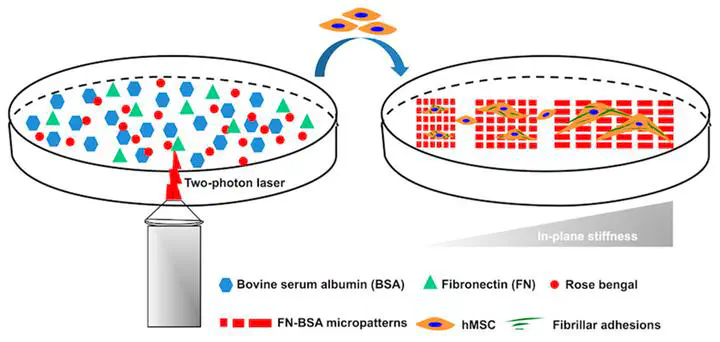New Paper: Multiphoton Fabrication of Fibronectin-Functionalized Protein Micropatterns: Stiffness-Induced Maturation of Cell–Matrix Adhesions in Human Mesenchymal Stem Cells

In this work, we investigate the niche factor(s) that influence(s) the maturation of fibrillar adhesions (FBA) and 3D matrix adhesions (3DMA) by using multiphoton fabrication-based micropatterning.
Check out the published paper here: https://doi.org/10.1021/acsami.7b07064
Abstract
Cell–matrix adhesions are important structures governing the interactions between cells and their microenvironment at the cell–matrix interface. The focal complex (FC) and focal adhesion (FA) have been substantially investigated in conventional planar culture systems using fibroblasts as an in vitro model. However, the formation of more mature types of cell–matrix adhesion in human mesenchymal stem cells (hMSCs), including fibrillar adhesion (FBA) and 3D matrix adhesion (3DMA), have not been fully elucidated. Here we investigate the niche factor(s) that influence(s) the maturation of FBA and 3DMA by using multiphoton fabrication-based micropatterning. First, the bovine serum albumin (BSA)-made protein micropatterns were functionalized by incorporating various concentrations of fibronectin (FN) in fabrication solution. The amount of cross-linked FN is positively correlated with the initial concentration of FN in the reaction liquid, as verified by immunofluorescence staining. On the other hand, the anisotropic FN-functionalized micropatterns were fabricated by varying the length (i.e., in-plane stiffness) and height (i.e., bending stiffness) of micropatterns, respectively. Finally, hMSCs were cultured on these micropatterns for 2 h and 1 day to determine the formation of FBA and 3DMA, respectively, using immunofluorescence staining. Results demonstrated that FN-functionalized micropatterns with high anisotropy in x–y dimension benefit FBA maturation. Furthermore, niche factors such as higher bending and in-plane stiffness and the presence of abundant fibronectin have a positive effect on the maturation of FN-based cell–matrix adhesion. These findings could provide some new perspectives on designing platforms for further cell niche study and rationalizing scaffold design for tissue engineering.